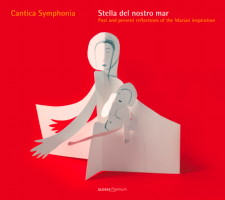
Motet and Lauda
Cantica Symphonia sing
sixteenth century motets -
and impress
GEORGE BALCOMBE'... so gentle yet precise ...'
|

|
Because of its crystal-clear acoustic, the Renaissance church at Colletto in Italy's Piedmontese hills is the performance venue of the unaccompanied vocal quartet from the Italian ensemble Cantica Symphonia. On this CD the ensemble sings fourteen works composed as venerations of the Virgin Mary. Two are modern, and the remaining twelve date from the late 1400s to the early 1500s.
Two similar kinds of music for vocal quartet had emerged in Italy -- the motet for learned persons and the lauda ('praise song') for the not so learned. Traditionally, motet texts tended towards the sacred and those of the lauda to the secular, but either was possible, while something of both was not unknown. An example of the latter not only forms the opening work of this CD but occupies no less than 3 minutes 55 seconds of the disc.
Listen -- Frater Petrus: Ave Maria, virgo serena
(track 1, 2:53-3:48) © 2008 MusiContact GmbH
This Ave Maria -- virgo serena ('Hail Mary -- Serene Virgin') was almost certainly composed by a Dominican monk Frater Petrus, at an unknown date but possibly before the 1520s. Be that as it may, this Ave Maria is a masterpiece. It may seem a contradiction in terms to call a lauda a masterpiece.
A lauda's four singers move in step with each other, as in a hymn, parting only at cadences which, here, are unbelievably beautiful. The lauda often had secular tunes converted into sacred use by simple four-part chords suitably arranged to be sung by non-professional singers. Sometimes, however, professional singers transformed the lauda into a musical masterpiece as in this 'Serene Virgin' Hail Mary.
The four voices of the Cantica Symphonia are so gentle yet precise; so subtle in their modulation of dynamics and so poignant in their expressiveness that they put other music to shame.
The lauda's vocal simplicity allows the text to be heard clearly. Motet singers, on the other hand, have the complexities of polyphony to deal with.
When motet music requires four different lines of text to be sung simultaneously, the text becomes chaotic. But chaos is no good when the words' meaning is more important than the musical sound. Not until the influence of classical Greek drama became important at the early Renaissance was this word/music dilemma resolved by having a recitative to tell the story and an aria to express the emotion.
Listen -- Josquin Des Prez: Gaude virgo mater Christi
(track 11, 0:00-2:11) © 2008 MusiContact GmbH
So, on this CD, while sections of text virtually disappear, nobody seemed to mind because the motet as such is basically a theme with variations, the theme often consisting of a plainchant distributed among the four voices and grouped to produce differences in sound and rhythm, and then to go on to variations such as the melisma.
The composers of motets heard here were elitist in many ways, not least in their international status and highly-placed positions in cathedrals and palaces scattered all over Europe.
Present on Cantica Symphonia's disc are :
Heinrich Isaac (1450-1517)
Josquin des Prez (1450-1521)
Jean Mouton (1459-1522)
Francisco de Peñalosa (1470-1528)
Ludwig Senfl (1486-1542)
Adrian Willaert (1490-1552)
There is also a sprinkling of Anons and two 21st century composers who in 2007 dedicated their motets to the Cantica Symphonia ensemble. They are Stella del nostro mar by Carlo Galante (born 1959) and Benedicta et Venerabilis by Yakov Gubanov (born 1954).
These statistics may be superfluous but they hint at the teeming background of life in the 1500s. And it must at least be of some significance that the oldest of these works (the anonymous Salve Regina) has origins in an antiphon from the eleventh century.
Listen -- anon: Salve Regina
(track 3, 5:35-7:02) © 2008 MusiContact GmbH
Copyright © 12 April 2009
George Balcombe,
London UK
 CD INFORMATION: STELLA DEL NOSTRO MAR
CD INFORMATION: STELLA DEL NOSTRO MAR
| 
